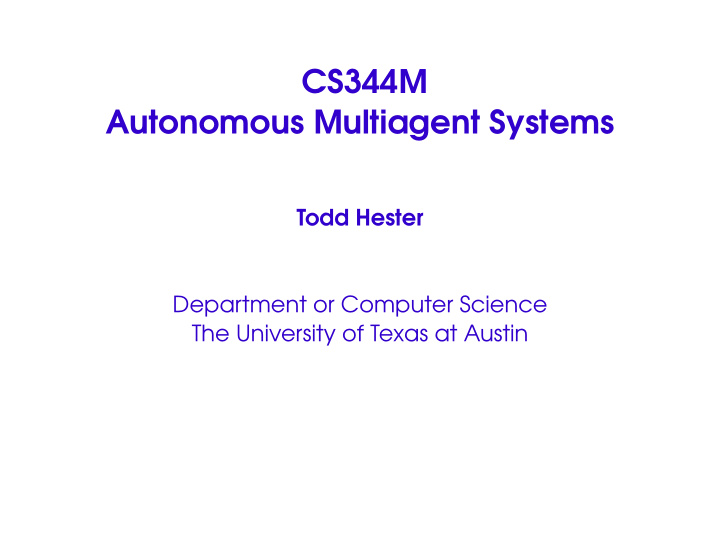



CS344M Autonomous Multiagent Systems Todd Hester Department or Computer Science The University of Texas at Austin
Good Afternoon, Colleagues Are there any questions? Todd Hester
Logistics • Programming assignment 4 Todd Hester
Logistics • Programming assignment 4 − 2D assignment Todd Hester
Logistics • Programming assignment 4 − 2D assignment • Final exam time: Monday Dec 17, 2-5 pm Todd Hester
Logistics • Programming assignment 4 − 2D assignment • Final exam time: Monday Dec 17, 2-5 pm − No exam − Final tournament and oral project presentation Todd Hester
Logistics • Programming assignment 4 − 2D assignment • Final exam time: Monday Dec 17, 2-5 pm − No exam − Final tournament and oral project presentation • Talks in the department: Todd Hester
Logistics • Programming assignment 4 − 2D assignment • Final exam time: Monday Dec 17, 2-5 pm − No exam − Final tournament and oral project presentation • Talks in the department: − Julian Bishop, PhD Proposal, Friday at 11am (ENS 31NM) − “Evolutionary Feature Discovery for Online Reinforcement Learning” Todd Hester
ACL Desiderata Todd Hester
ACL Desiderata Form: simple, readable, concise, easy to parse and generate, extensible Todd Hester
ACL Desiderata Form: simple, readable, concise, easy to parse and generate, extensible Content: well-defined primitives, flexible content Todd Hester
ACL Desiderata Form: simple, readable, concise, easy to parse and generate, extensible Content: well-defined primitives, flexible content Semantics: unambiguous, address location and time Todd Hester
ACL Desiderata Form: simple, readable, concise, easy to parse and generate, extensible Content: well-defined primitives, flexible content Semantics: unambiguous, address location and time Implementation: efficient, networking issues hidden, amenable to partial implementation Todd Hester
ACL Desiderata Form: simple, readable, concise, easy to parse and generate, extensible Content: well-defined primitives, flexible content Semantics: unambiguous, address location and time Implementation: efficient, networking issues hidden, amenable to partial implementation Networking: usable on top of existing protocols Todd Hester
ACL Desiderata Form: simple, readable, concise, easy to parse and generate, extensible Content: well-defined primitives, flexible content Semantics: unambiguous, address location and time Implementation: efficient, networking issues hidden, amenable to partial implementation Networking: usable on top of existing protocols Environment: interoperability with other languages Todd Hester
ACL Desiderata Form: simple, readable, concise, easy to parse and generate, extensible Content: well-defined primitives, flexible content Semantics: unambiguous, address location and time Implementation: efficient, networking issues hidden, amenable to partial implementation Networking: usable on top of existing protocols Environment: interoperability with other languages Reliability: reliable, secure, authentication possible, error handling Todd Hester
{Per,Il}locution Locution: What is said (physical) Todd Hester
{Per,Il}locution Locution: What is said (physical) Illocution: What is meant Todd Hester
{Per,Il}locution Locution: What is said (physical) Illocution: What is meant Perlocution: Intended effects Todd Hester
{Per,Il}locution Locution: What is said (physical) Illocution: What is meant Perlocution: Intended effects Example: “Please close the window.” Todd Hester
{Per,Il}locution Locution: What is said (physical) Illocution: What is meant Perlocution: Intended effects Example: “Please close the window.” Illocution – Performatives Todd Hester
Three-layer organization • Content: free-form (domain-dependent) Todd Hester
Three-layer organization • Content: free-form (domain-dependent) • Communication: who is sending, etc. Todd Hester
Three-layer organization • Content: free-form (domain-dependent) • Communication: who is sending, etc. • Message: performatives and fields (standard) Todd Hester
Three-layer organization • Content: free-form (domain-dependent) • Communication: who is sending, etc. • Message: performatives and fields (standard) (tell :sender stock-server :content (PRICE IBM 14) :receiver joe :in-reply-to ibm-stock :language LPROLOG :ontology NYSE-TICKS) Todd Hester
Three-layer organization • Content: free-form (domain-dependent) • Communication: who is sending, etc. • Message: performatives and fields (standard) (tell :sender stock-server :content (PRICE IBM 14) :receiver joe :in-reply-to ibm-stock :language LPROLOG :ontology NYSE-TICKS ) Todd Hester
ACLs – Current Landscape “Languages exist to serve a purpose, namely the communication between willing—and occasionally unwilling—participants” Todd Hester
ACLs – Current Landscape “Languages exist to serve a purpose, namely the communication between willing—and occasionally unwilling—participants” • There are different options • Subtle differences Todd Hester
ACLs – Current Landscape “Languages exist to serve a purpose, namely the communication between willing—and occasionally unwilling—participants” • There are different options • Subtle differences • Why a standard? − What are the pros and cons? Todd Hester
ACLs – Current Landscape “Languages exist to serve a purpose, namely the communication between willing—and occasionally unwilling—participants” • There are different options • Subtle differences • Why a standard? − What are the pros and cons? • How are they created? Todd Hester
ACLs – Current Landscape “Languages exist to serve a purpose, namely the communication between willing—and occasionally unwilling—participants” • There are different options • Subtle differences • Why a standard? − What are the pros and cons? • How are they created? • Sample FIPA applications on resources page Todd Hester
Soccer server communication • What is the soccer server communication protocol? • How does it relate? Todd Hester
Soccer server communication • What is the soccer server communication protocol? • How does it relate? • Does an ACL make sense in the soccer server? If so, under what circumstances? Todd Hester
Soccer server communication • What is the soccer server communication protocol? • How does it relate? • Does an ACL make sense in the soccer server? If so, under what circumstances? An example protocol Todd Hester
Communication Disruption How could an opponent team disrupt team communication? Todd Hester
Communication Disruption How could an opponent team disrupt team communication? Actual instances Todd Hester
Recommend
More recommend